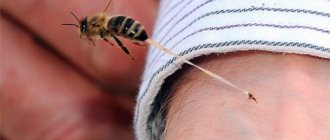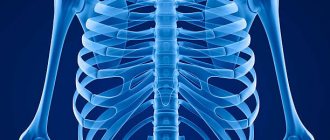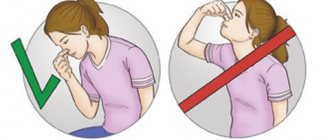Bronchospasm is an acute condition in which the peribronchial muscles contract, which causes a decrease in the lumens. Bronchospasm leads to an almost complete cessation of the removal of carbon dioxide from the body and a serious decrease in the volume of incoming oxygen. As a rule, it is very difficult for a patient to exhale, for which he has to make an effort; inhaling is also more difficult for him than for a healthy person, although less effort is made than for exhalation. With the help of a stethoscope, you can clearly hear exhalation sounds.
Bronchospasm is a very dangerous condition that requires immediate medical attention. People who are prone to it are strictly recommended to carry medications that can interrupt attacks. Medicines should be used only those prescribed by a doctor - self-medication of bronchospasms is life-threatening.
Causes/factors of bronchospasm
Bronchospasm can be a consequence of both illness and an allergic reaction to irritants, the result of intoxication and some other reasons. In general, the main causes and factors influencing the manifestation of the disease are as follows:
- bronchitis, bronchial asthma, exacerbation of obstructive chronic pulmonary disease;
- allergic reactions (anaphylaxis) to tobacco smoke, chemicals, dust or other substances;
- stress or increased physical activity (especially in patients with asthma);
- foreign bodies in the bronchi;
- side effects of drugs.
Help for elderly people in boarding houses “Longevity” with bronchospasms
Boarding houses for the elderly "Longevity" (private nursing homes) provide assistance to elderly people with various diseases, including diseases of the respiratory system, allergies, asthma and many other problems.
Our employees monitor residents of boarding houses for the elderly around the clock , so the likelihood of a threat to the lives of patients when bronchospasm or other dangerous condition occurs is much lower than when caring for the elderly at home.
The medical staff of boarding houses is always nearby and ready to provide first aid. In addition, the Longevity Medical Center prescribes drug treatment, complex therapy and a number of preventive measures aimed at the general health of older people. Predisposing factors that cause exacerbation of symptoms of the disease are excluded. Treatment is aimed both at eliminating the cause (the underlying disease causing bronchospasm) and at improving the overall quality of life. Proper nutritious nutrition, developed by nutritionists taking into account the needs of an elderly person, a calm environment and clean air, and, if possible, giving up bad habits, all this together has a healing effect on elderly people living in our boarding houses.
Diagnostics
Diagnosing bronchospastic syndrome is not difficult, especially if doctors catch the patient during an attack. If the disease is just beginning, general clinical research methods are prescribed. At the same time, an increased level of eosinophils and leukocytes is detected in the blood, and the sputum analysis contains components characteristic of bronchospasm - Charot-Leiden crystals, Kurshman spirals.
X-ray examination reveals changes in the transparency of the pulmonary fields and changes in the pleura, emphysematous pulmonary tissue, and the presence of pleurodiaphragmatic adhesions.
Certain difficulties arise when diagnosing latent bronchospasm, since it occurs without pronounced clinical signs. In this case, pharmacological tests are carried out using obsidan and acetylcholine.
Bronchial obstruction syndrome (bronchospastic syndrome)
The basis of bronchospastic syndrome
there is a violation of bronchial obstruction. The term “bronchospastic syndrome” has synonyms - “bronchial obstruction syndrome”, “bronchial obstruction syndrome”, “bronchial obstruction syndrome”, “asthmatic syndrome or component”.
Bronchospastic syndrome is observed in diseases and pathological conditions that occur with impaired bronchial patency. This happens with spasm of their smooth muscles, swelling of the mucous membrane during inflammatory or congestive phenomena in the bronchopulmonary system, obstruction of the bronchi with vomit, sputum, tumor, foreign body, as well as cicatricial narrowing of the bronchi and their compression from the outside by the tumor.
The resistance to the air stream flow increases in proportion to the degree of lumen of the bronchus through which the air passes. Therefore, when the lumen of the airways narrows, the work of the respiratory muscles sharply increases. Bronchospastic syndrome determines the obstructive nature of alveolar ventilation disorders in acute and chronic respiratory failure.
Bronchospastic syndrome is divided according to its etiology into primary and secondary (symptomatic), and according to the nature of its course - into paroxysmal and chronic.
Primary bronchospastic syndrome underlies bronchial asthma. The main symptom of this disease is an attack of suffocation caused by bronchial hyperreactivity, and the main pathogenetic mechanisms are spasm of bronchial smooth muscles, hypersecretion of the bronchial glands and swelling of the bronchial mucosa.
Secondary,
or symptomatic, bronchospastic syndrome is causally associated with other (except bronchial asthma) diseases or pathological conditions that can lead to bronchial obstruction. It most often occurs in diseases of allergic origin (anaphylactic shock, laryngeal edema), autoimmune and infectious-inflammatory diseases of the bronchopulmonary apparatus, obstructive pathological processes (malignant and benign tumors, bronchostenosis due to tuberculosis, burns of the respiratory tract), diseases of the circulatory system causing hemodynamic disorders in the bronchopulmonary apparatus (primary pulmonary hypertension, pulmonary embolism, congestive left ventricular failure).
Clinical manifestations of bronchospastic syndrome
Regardless of the etiology and pathogenetic mechanisms, in most cases the same type - shortness of breath and attacks of suffocation, often of the expiratory type, paroxysmal cough, respiratory sounds audible at a distance (usually dry wheezing).
Paroxysmal bronchospastic syndrome occurs in the form of an attack of suffocation that develops suddenly or within a short time, often at night. Patients feel a sudden lack of air. Dyspnea is usually expiratory in nature, but can be inspiratory or mixed. During an attack, breathing is noisy, wheezing, and can be heard from a distance. Patients usually take a forced position. They prefer to sit leaning forward and resting their hands on their knees, the edge of a table, bed or window sill, which helps to include auxiliary muscles in breathing. The facial expression is pained, speech is difficult (with a severe attack of suffocation, almost impossible). Patients are worried, scared, gasping for air. The face is pale, with a bluish tint, covered with profuse cold sweat.
A cough with bronchospastic syndrome can be dry and wet. A dry cough (irritation cough, nonproductive cough), in which sputum is not expectorated, is observed in the initial period of an acute inflammatory or edematous process in the trachea and bronchi, for example, during an attack of bronchial asthma. When inhaling smoke and other irritating substances, or getting a foreign body or pieces of food into the respiratory tract, an attack of severe dry cough occurs. A constant dry cough is characteristic of stenosis of the trachea and large bronchi, compression by a tumor or enlarged lymph nodes. In these cases, the cough is paroxysmal and has a rattling, nasal tone.
In case of acute inflammatory or edematous process in the larynx, trachea and large bronchi, for example, acute laryngitis or tracheobronchitis, the cough is rough, barking, combined with hoarseness or aphonia, sore throat. Attacks of such a cough can lead to suffocation, cyanosis and even result in a short-term loss of consciousness, which often gives rise to an erroneous diagnosis of bronchial asthma. A silent, weak and short cough indicates damage to the small bronchi and bronchioles.
A productive (wet) cough, in which sputum is released, is observed in diseases accompanied by hypersecretion of bronchial mucus, as well as the appearance of exudate or transudate in the bronchial lumen, for example, with bronchitis, bronchiectasis, pulmonary edema, a breakthrough in the bronchus of an abscess, or a parasitic cyst. By the nature of the productive cough one can judge the level of obstruction in the bronchi. In cases where sputum is expectorated easily, without much difficulty, the pathological process is located not far from the glottis. When the sputum is deeper, it is coughed up with difficulty in the form of a small lump, usually after a short cough.
In chronic diseases of the larynx and trachea, with prolonged stagnation of blood in the lungs in patients with pathologies of the circulatory system, the cough is usually constant and is provoked by mildly irritating odors and even changes in the temperature and humidity of the inhaled air.
Visual observations of sputum allow us to make an assumption about the nature of the underlying disease or pathological process. For example, a cough with light, mucous, viscous sputum is observed with tracheitis and acute bronchitis at the onset of the disease, later the sputum becomes greenish, mucopurulent. In chronic bronchitis with damage to large bronchi, the sputum is mucopurulent or purulent, the amount is moderate, sometimes very scanty. When the process is localized in the medium-sized bronchi, the cough is wet, often in the morning, with the separation of mucopurulent sputum. When small bronchi are affected (obstructive bronchitis), as a result of a painful, dull, weakened cough, a small amount of viscous, thick mucous or mucopurulent sputum is difficult to separate. Bloody sputum is observed with pulmonary infarction, tuberculosis, bronchial cancer, and with congestion in the pulmonary circulation. Sputum that looks like “raspberry jelly” is a late symptom of bronchial cancer.
The time of cough onset has a certain diagnostic significance. With chronic inflammation of the upper respiratory tract, especially in smokers, cough is usually observed in the morning. In patients with allergic bronchitis and bronchial asthma, cough appears mainly at night and upon contact with an allergen.
Objective
confirmation of bronchospastic syndrome is the expansion of the chest, which is as if in the inhalation position. The veins of the neck swell during inhalation and collapse during exhalation. The muscles of the shoulder girdle, back, abdominal wall and intercostal muscles actively participate in the act of breathing. The rhythm and depth of breathing changes.
If there is difficulty in inhaling, you can detect a predominant contraction of the intercostal muscles and m. sternoclaidomastoidei, which in the chronic course of bronchospastic syndrome become hypertrophied and appear in the form of dense thick cords. With difficulty in exhaling, a predominant contraction of the abdominal muscles is observed, which causes a rise in the diaphragm and an increase in intrathoracic pressure.
If there is a significant obstruction to the flow of air into the lungs and back, a decrease in breathing is observed. If an obstruction occurs in the large bronchi, the duration of inspiration increases (inspiratory dyspnea), and breathing during inspiration becomes noisy (stridor). When the passage of air in the small bronchi and bronchioles is difficult, prolongation of exhalation (expiratory dyspnea) is observed, during which loud, prolonged wheezing can be heard even at a distance. Rare shallow breathing occurs with significant narrowing of the glottis and obstructive form of pulmonary emphysema.
On palpation of the chest
its rigidity is revealed, which indicates acute (during an attack of suffocation) or chronic pulmonary emphysema. Vocal tremors are weakened on the side of the obstruction of the conducting bronchus. If the bronchus is clogged with a lump of mucus, then after expectoration the vocal tremor is again determined quite clearly. In case of total bronchospasm, for example, in bronchial asthma, a uniform weakening of vocal tremors may be due to the development of pulmonary emphysema.
With comparative percussion
A box sound often appears above the lungs. Topographic percussion can detect prolapse of the lower borders of the lungs. The excursion of the lower pulmonary border decreases.
Auscultation
weakened vesicular breathing is determined in patients with widespread (diffuse) narrowing of the airways, with an obstructive form of pulmonary emphysema or obstructive atelectasis. With a sharp and uneven narrowing of the lumen of the small bronchi and bronchioles due to inflammatory swelling of their mucous membrane (bronchitis), hard breathing is heard, i.e. especially increased vesicular respiration. When the passage of air from the small bronchi and bronchioles to the alveoli is difficult and their non-simultaneous expansion, intermittent (saccade) breathing is heard in a limited area of the lungs (usually in the area of the apexes of the lungs). When the trachea or large bronchus narrows (tumor, edema) over the area of stenosis, stenotic breathing (sharply increased physiological bronchial breathing) is heard.
Of the additional respiratory sounds for bronchospastic syndrome, dry wheezing is the most typical. They are heard during inspiration and especially during exhalation. Dry wheezing is formed in the bronchi when they are narrowed or when there is a viscous secretion in them in the form of threads or bridges. If low bass dry rales are heard, then the obstructive process is localized in the large and medium bronchi, if voiced, whistling - in the small bronchi and bronchioles. When the trachea and main bronchi are blocked by bronchial secretions or other fluid in the lungs, coarse, often bubbling, moist rales are heard. These wheezes are detected during inhalation and exhalation, and are also clearly audible from a distance. When medium-sized bronchi or small bronchi and bronchioles are blocked by fluid, medium- and fine-bubbly moist rales are detected, respectively.
During an attack, the pulse is rapid, weak in filling, heart sounds are muffled, and there is often an increase in blood pressure (pulmonogenic hypertension).
The attack of suffocation ends with the discharge of thick viscous sputum, often in the form of casts of the bronchi, after which breathing gradually becomes freer and wheezing disappears.
The duration of an attack of suffocation can vary - from several minutes to several hours, but there can be attacks that last up to a day or more, for example, status asthmaticus in bronchial asthma.
The chronic course of bronchospastic syndrome is characterized by a changing nature of shortness of breath depending on various factors - physical and psycho-emotional stress, weather, time of day, the course of the underlying disease that caused bronchial obstruction (dyspnea of the “day after day” type). With a long course of bronchospastic syndrome, chronic pulmonary emphysema develops, and subsequently chronic pulmonary heart disease.
The cause of death in bronchospastic syndrome can be asphyxia, acute heart failure, and paralysis of the respiratory center.
Additional research methods.
For the diagnosis of bronchospastic syndrome, the most important are x-ray studies and methods for studying the function of external respiration (spirography and pneumotachometry).
Obstructive disorders are characterized by a decrease in speed indicators of spirography and the flow-volume loop - forced vital capacity (FVC) and maximum pulmonary ventilation (MVV), forced expiratory volume in the first second (FEV1), as well as FEV1/VC (Tiffenau index). The level of bronchial obstruction (small, medium, large) is determined by the indicators of the air flow loop - volume.
Obstructive disorders are also confirmed by pneumotachometry (decreased maximum expiratory flow), a positive test with bronchodilators and a test with a match according to Votchal. The last test is considered positive if the patient is unable to blow out (extinguish) a lit match at a distance of 8 cm from the mouth. In the chronic course of bronchospastic syndrome due to developed pulmonary emphysema, vital capacity decreases.
During an attack of suffocation, x-rays often reveal, along with signs of the underlying disease, acute pulmonary emphysema - increased transparency of the lungs, horizontal position of the ribs, widening of the intercostal spaces, low standing of the diaphragm.
The ECG shows signs of increased load on the right side of the heart, which indicates the formation of cor pulmonale.








